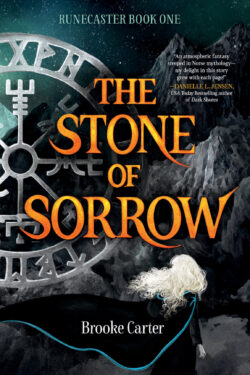#927 A runecaster’s apprenticeship
Runecaster Book 1: The Stone of Sorrow
by Brooke Carter
Victoria: Orca Book Publishers
$14.95 / 9781459824393
Reviewed by Myshara Herbert-McMyn
*
 The Stone of Sorrow concerns magic, myth, and adventure. Each page I turned of this YA (young adult) novel meant more mystery and surprise. I wasn’t sure how much Icelandic and Norse mythology would come to life in the pages, but there was much more than I knew. As a lover of both YA and fantasy novels, I was excited to read this one. I grew up reading mythology-inspired works like Rick Riordan’s Percy Jackson series and I was intrigued when I realized the premise of this novel.
The Stone of Sorrow concerns magic, myth, and adventure. Each page I turned of this YA (young adult) novel meant more mystery and surprise. I wasn’t sure how much Icelandic and Norse mythology would come to life in the pages, but there was much more than I knew. As a lover of both YA and fantasy novels, I was excited to read this one. I grew up reading mythology-inspired works like Rick Riordan’s Percy Jackson series and I was intrigued when I realized the premise of this novel.
Seventeen-year-old Runa Unnursdóttir is a runecaster apprenticed to her older sister Sỳr when a terrible attack befalls their village. With a great evil plaguing her people, Runa sets out on a quest to save them — and her imprisoned sister — by competing in the island’s ancient runecasting competition. Runa meets a variety of strange and interesting people along the way, some who help and some who hinder. All will play a role in helping Runa become who she needs to be.

The Stone of Sorrow will be a treat for those readers who have already fallen in love with Norse mythology and an amazing introduction for others. I hope that it will prompt those newcomers to investigate this rich mythic literature and learn more about the runes and monsters that feature in The Stone of Sorrow. I love novels that urge me to learn more outside of their pages. This doesn’t mean an author doesn’t know their onions — on the contrary, it means a writer secure in the knowledge that they don’t need to tell everything. Such an author will gain my trust by sparking my hunger for more knowledge. I knew only the rudiments of Norse mythology when I started this book, but now I want to read more about the complex magic and pantheon of Norse gods. I hope that this novel can inspire a similar kind of knowledge-quest in other readers.
One thing I look for when I read a fantasy novel is worldbuilding versus pacing. The amount and frequency of description can be a determining factor in making a good novel. Carter has found the perfect balance between frequency and amount: the novel kept its quick and consistent pace from inciting incident to climax. This made The Stone of Sorrow a page-turner I didn’t want to put down — and in truth, I read it in less than a day. My rapid progress helped me see the curvature of the plot more clearly over the course of the novel. The Stone of Sorrow has a well-shaped plot structure: most of the action happens in the long second act, while the first and third acts (the introduction and climax/conclusion) are relatively short and solid. Carter’s well-balanced worldbuilding in the introductory part of the book helped me understand the laws of her created world early on, and this, in turn, provided a solid base that allowed the rest of the story to run smoothly, and helped me to focus on the action.
Runa Unnursdóttir is a well-built character. She is solidly characterized from the start, and I learned more about her from her own thoughts and the characters around her. It began to feel like her characterization was contradictory, but I realized it was exactly right for a young woman. Everyone experiences self-doubt that might be invisible to those around them. Our families and friends are exactly the people to give us that other point of view – to help us see ourselves in a more positive light. Runa struggles with her perception of herself throughout the story, a quest for self-understanding that adds more depth to her character as she journeys.

The Stone of Sorrow follows a classic quest plot, with a good number of complex twists and setbacks. Runa follows quite the circuitous route in her journey, but the events are more necessary than they first appear. I wish I could say more about certain events and characters that present an interesting amount of foreshadowing. These characters and events tended to confuse me – as they confused Runa — but I flagged them as important and kept them in the back of my mind. By the end of the novel, I knew that Runa’s quest has barely begun.
Brooke Carter’s The Stone of Sorrow kept me guessing from beginning to end. I enjoyed every part of it, from the engaging writing to the exciting plot. I couldn’t predict the ending, even though I tried hard to guess whenever I got new information. To me, unpredictability is a characteristic of a good book. It is only right that we don’t know how things will turn out. After following Runa’s journey in this first novel, the cliff hanger was everything that I wanted. I eagerly await the chance to return to Carter’s small island world in her next Runecaster novel.
*

Myshara Herbert-McMyn is a teacher candidate at University of British Columbia, Okanagan. She holds a Bachelor of Arts in English and Creative Writing from Thompson Rivers University. Editor’s note: Myshara Herbert-McMyn has recently written reviews of books Paul Bae and Ruth Daniell. Previously, with her TRU mentor Ginny Ratsoy, she published reviews of books by Roo Phelps and Tim Conley. Myshara lives in Kelowna.
*
The Ormsby Review. More Books. More Reviews. More Often.
Publisher and Editor: Richard Mackie
The Ormsby Review is a journal service for in-depth coverage of B.C. books and authors. The Advisory Board consists of Jean Barman, Robin Fisher, Cole Harris, Wade Davis, Hugh Johnston, Patricia Roy, David Stouck, and Graeme Wynn. Scholarly Patron: SFU Graduate Liberal Studies. Honorary Patron: Yosef Wosk. Provincial Government Patron since September 2018: Creative BC
“Only connect.” – E.M. Forster